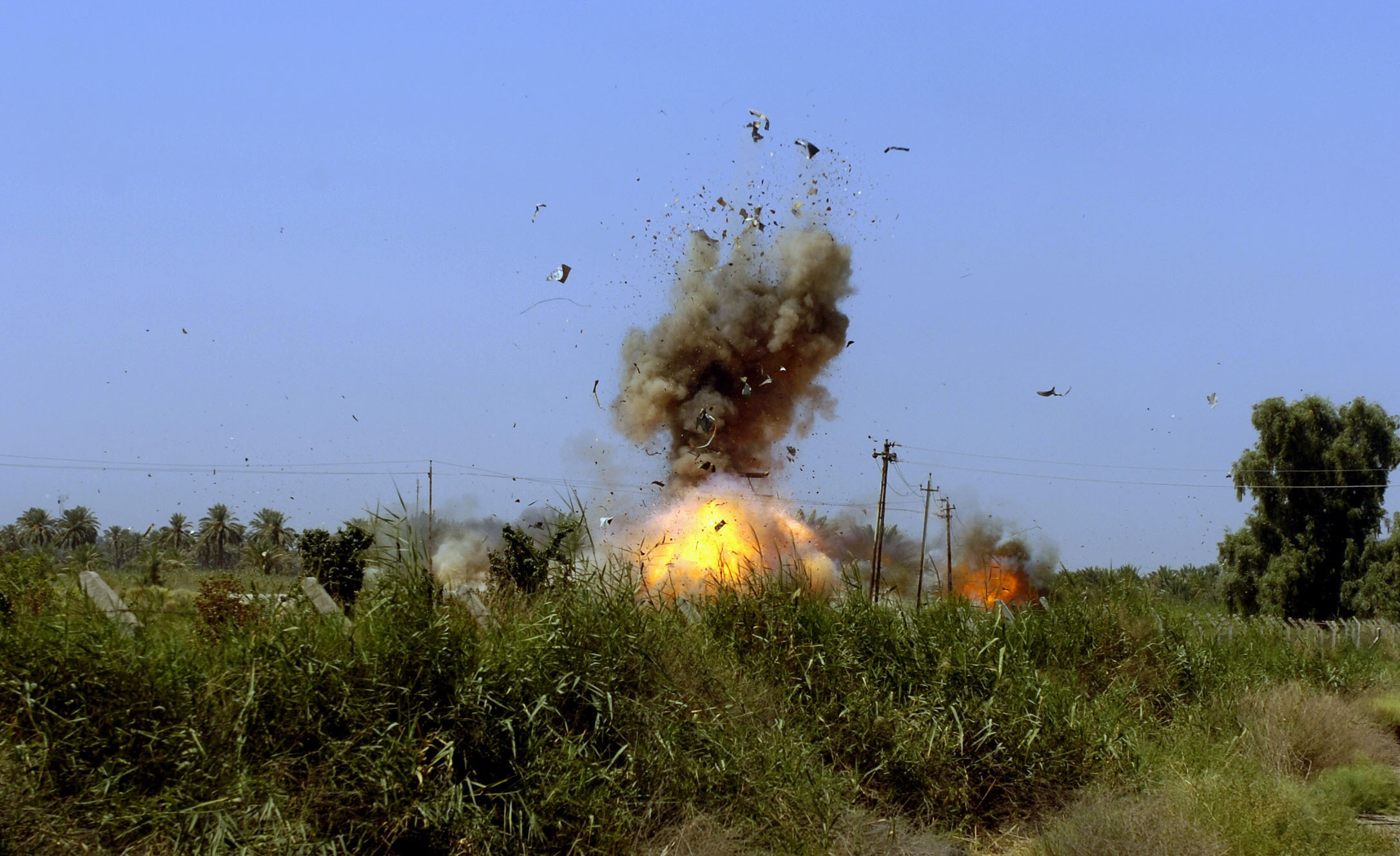

Explosively formed penetrators (or projectiles), better known as EFPs, were responsible for wounding and killing many American military personnel throughout the War on Terror, quickly earning a reputation for their ability to punch through armor during Operation Iraqi Freedom.
In a report on EFP fatalities declassified several years ago, 195 American service members were killed and close to 900 wounded by EFPs from July 2005 to November 2011. The lethality of these devices forced the American military to find and implement new defensive technologies and tactics as countermeasures to combat EFPs throughout the war.

What is an EFP?
An EFP is a copper warhead that, once detonated, is superheated, turning it into a molten projectile that can punch through almost anything — including M1 Abrams tanks and MRAPs. They are usually designed to be triggered by motion, remotely, or via pressure switches like other types of IEDs.
“EFPs are a kind of mine that has two special characteristics. One is that the mine can be deployed quite far away from the side of a road or wherever the target is,” said Dr. Michael Knights, a Jill and Jay Bernstein Fellow at The Washington Institute.
Knights has traveled throughout Iraq, Yemen, and the Gulf States and regularly briefs U.S. government policymakers, congressional committees, and U.S. military officers on regional security affairs.
Subscribe to Task & Purpose Today. Get the latest military news and culture in your inbox daily.
“And second, they have a very powerful, armor-piercing effect that can penetrate even the most modern main battle tanks,” Knights said.
Knights explained that a particularly lethal aspect of EFPs is their ability to hide in plain sight, sometimes hung under a bridge, within a brick wall, the upper part of a lamppost, or in a HESCO barrier. Although EFPs can be used as an accurate munition, as the war on terror continued the creators of these menacing improvised explosive devices designed them to be daisy-chained area weapons to counter America’s defensive measures.
History of EFP bombs in the War on Terror
After U.S. forces invaded Iraq, EFPs surfaced and caused an abrupt change in tactics. When the molten projectiles started disabling heavily armored vehicles, among other types of IEDs, the military implemented jamming systems to prevent remote triggers.
Then terrorists switched to command wires, which carried an electric charge from the ignitor to the main device, rendering jamming useless. The military’s technology advanced, and drones could pick up the wires and warn incoming personnel.
In a third evolution, EFPs were set up with a passive infrared motion sensor. Knights said terrorists would wait until there were no vehicles between the EFP and the incoming convoy, then they would arm the EFP remotely before the convoy’s jamming system was in range.
The military found a way to bypass the motion sensors by using booms that could trigger the motion sensor trigger in front of the vehicle. That evolution caused the molten projectile to fly in front of the vehicle, often missing it entirely. Terrorists then switched to offset EFPs, so the U.S. responded with variable-length booms, making it harder to offset the explosion accurately.
“Those were the kinds of back and forth. It was really mainly about initiation. […] So it wasn’t about armoring, it was about pre-detonating, or it was about attacking the network,” Knights said. “In other words, proactively going and finding the attack network and killing them. Stopping these devices from getting into country in the first place.”
EFPs in Ukraine
Not all EFPs are the same, but all of them are deadly. Reports of EFP devices being used to counter armor in Ukraine have surfaced on the internet. A video shared to NextaTV’s X (formerly Twitter) account shows an airburst-style munition claiming to be an EFP. After the airburst, an impact is visible on the Russian anti-aircraft system, followed by flames belching upward into the sky.
It’s possibly a 155mm BONUS Howitzer round fired from an M114 Howitzer — basically an EFP on steroids, and one of Ukraine’s most requested weapons. Once fired, the carrier shell separates in the air, releasing two individual sensor-fuzed warheads with the ability to seek out their own targets within a range of 32,000 square meters. The shell fired from a NATO L52 gun can reach out to 35 kilometers, or approximately 22 miles.
Russia has used IEDs in Ukraine, leaving them as counter-measures during withdrawals but concrete proof of improvised EFPs isn’t available yet.
How to defeat EFPs
The most effective way to counter EFPs, according to Knights, is using a counter-intelligence strategy to find and take out EFP manufacturers. Though it’s not a 100% effective means of countering roadside EFPs, it compliments defensive measures like variable-length booms, and jamming equipment troops can add to their armored vehicles.
RAFAEL’s Reactive Armor Tiles and the ShieldAll armor system, developed by Battelle and produced by PVI, both claim to be effective measures to counter EFPs and other types of penetrating impacts, but due to the sensitive nature of the research, very little is declassified.
The latest on Task & Purpose
- How a Native Alaskan became a legendary Navy SEAL
- Military secrets leaked on ‘War Thunder’ forums yet again
- US Navy decommissions another littoral combat ship, the USS Milwaukee
- Who will be the president’s top military adviser after Gen. Milley retires?
- 4,500 3rd Infantry Division soldiers deploying to Eastern Europe